QAB020N504S - Cross-Cultural Management: Manager Goes Native Podcast
VerifiedAdded on 2023/04/11
|8
|1431
|324
Case Study
AI Summary
This case study, presented as a podcast transcript, analyzes the dilemmas faced by Graham Steinberg, VP of US Hydro Generation (HG), in deciding whether to re-appoint Brett Jones as project liaison specialist in Tanzania. The discussion, involving Joel, Antonella, Donatas, Marta, and Nedko, delves into issues arising from Brett's actions, such as nepotism and bribery, through the lens of cross-cultural management theories like Hofstede's cultural dimensions, GLOBE's leadership dimensions, and Hertzberg's motivation theory. The analysis explores the conflict between organizational culture and local customs, the impact of power distance and long-term orientation on decision-making, and the ethical implications of Brett's practices within the Tanzanian context. The podcast further examines the influence of high-context communication and traditional values on project outcomes, highlighting the challenges in resolving cross-cultural management issues and ethical conflicts, and the potential for high employee turnover and negligence due to these factors.

Paraphrase This Document
Need a fresh take? Get an instant paraphrase of this document with our AI Paraphraser
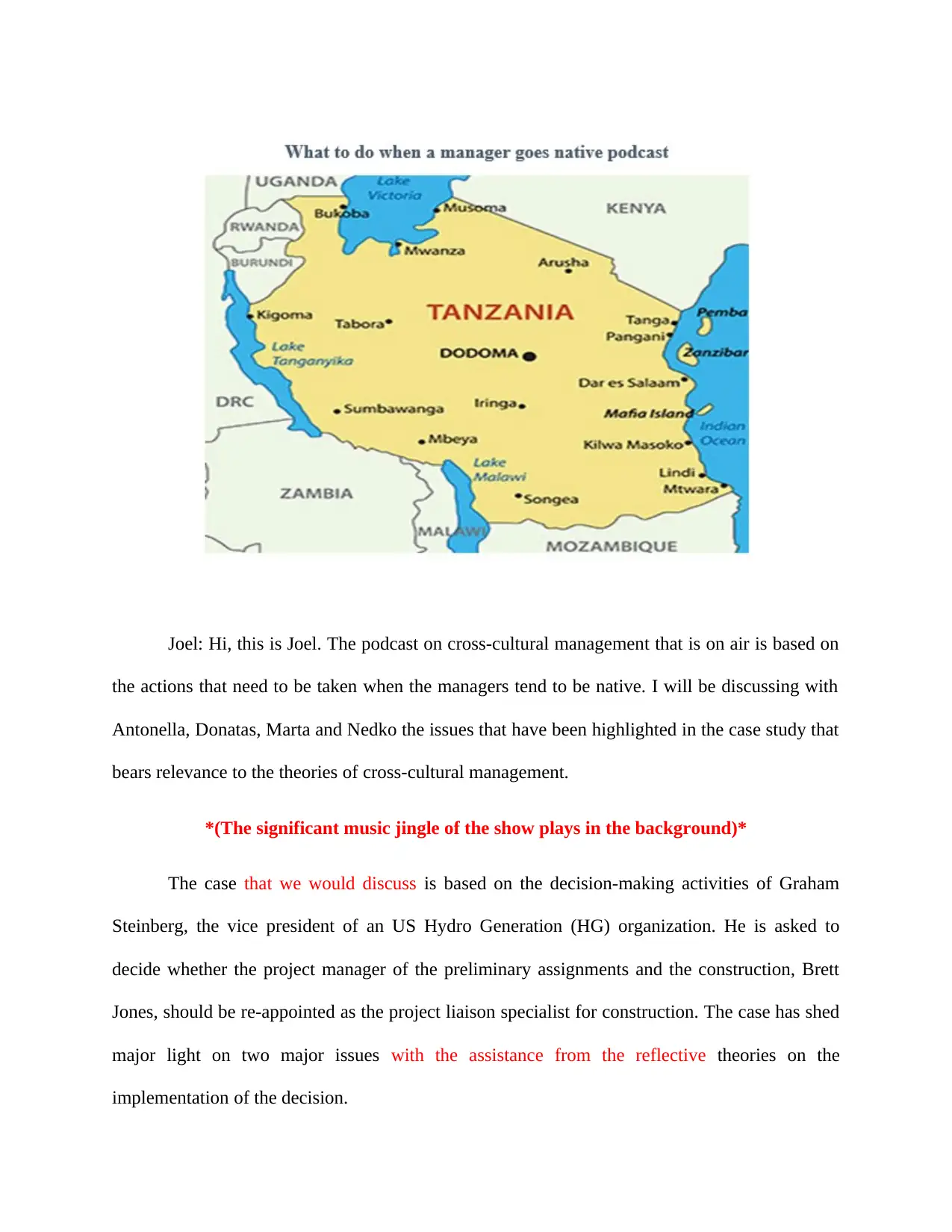
Joel: Hi, this is Joel. The podcast on cross-cultural management that is on air is based on
the actions that need to be taken when the managers tend to be native. I will be discussing with
Antonella, Donatas, Marta and Nedko the issues that have been highlighted in the case study that
bears relevance to the theories of cross-cultural management.
*(The significant music jingle of the show plays in the background)*
The case that we would discuss is based on the decision-making activities of Graham
Steinberg, the vice president of an US Hydro Generation (HG) organization. He is asked to
decide whether the project manager of the preliminary assignments and the construction, Brett
Jones, should be re-appointed as the project liaison specialist for construction. The case has shed
major light on two major issues with the assistance from the reflective theories on the
implementation of the decision.
the actions that need to be taken when the managers tend to be native. I will be discussing with
Antonella, Donatas, Marta and Nedko the issues that have been highlighted in the case study that
bears relevance to the theories of cross-cultural management.
*(The significant music jingle of the show plays in the background)*
The case that we would discuss is based on the decision-making activities of Graham
Steinberg, the vice president of an US Hydro Generation (HG) organization. He is asked to
decide whether the project manager of the preliminary assignments and the construction, Brett
Jones, should be re-appointed as the project liaison specialist for construction. The case has shed
major light on two major issues with the assistance from the reflective theories on the
implementation of the decision.
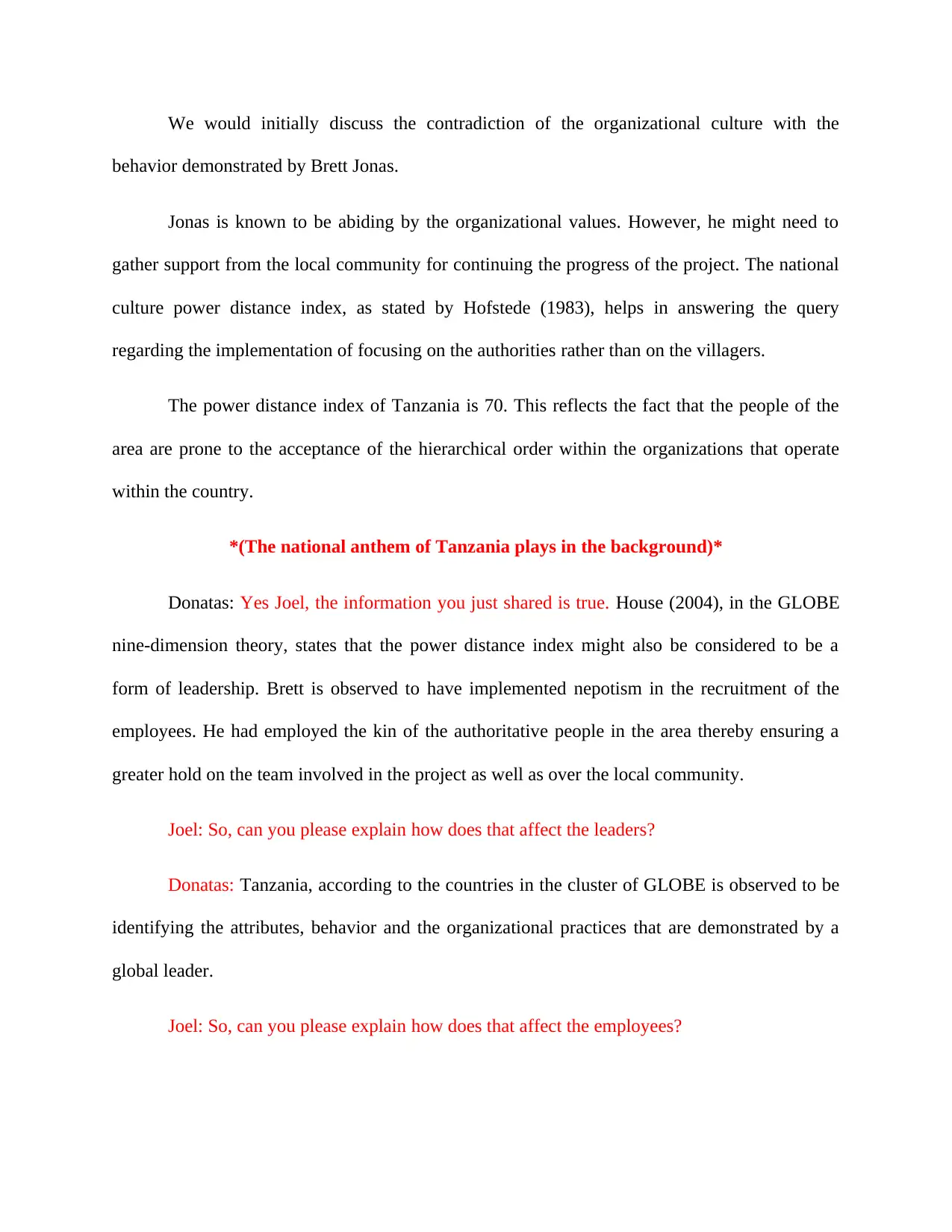
We would initially discuss the contradiction of the organizational culture with the
behavior demonstrated by Brett Jonas.
Jonas is known to be abiding by the organizational values. However, he might need to
gather support from the local community for continuing the progress of the project. The national
culture power distance index, as stated by Hofstede (1983), helps in answering the query
regarding the implementation of focusing on the authorities rather than on the villagers.
The power distance index of Tanzania is 70. This reflects the fact that the people of the
area are prone to the acceptance of the hierarchical order within the organizations that operate
within the country.
*(The national anthem of Tanzania plays in the background)*
Donatas: Yes Joel, the information you just shared is true. House (2004), in the GLOBE
nine-dimension theory, states that the power distance index might also be considered to be a
form of leadership. Brett is observed to have implemented nepotism in the recruitment of the
employees. He had employed the kin of the authoritative people in the area thereby ensuring a
greater hold on the team involved in the project as well as over the local community.
Joel: So, can you please explain how does that affect the leaders?
Donatas: Tanzania, according to the countries in the cluster of GLOBE is observed to be
identifying the attributes, behavior and the organizational practices that are demonstrated by a
global leader.
Joel: So, can you please explain how does that affect the employees?
behavior demonstrated by Brett Jonas.
Jonas is known to be abiding by the organizational values. However, he might need to
gather support from the local community for continuing the progress of the project. The national
culture power distance index, as stated by Hofstede (1983), helps in answering the query
regarding the implementation of focusing on the authorities rather than on the villagers.
The power distance index of Tanzania is 70. This reflects the fact that the people of the
area are prone to the acceptance of the hierarchical order within the organizations that operate
within the country.
*(The national anthem of Tanzania plays in the background)*
Donatas: Yes Joel, the information you just shared is true. House (2004), in the GLOBE
nine-dimension theory, states that the power distance index might also be considered to be a
form of leadership. Brett is observed to have implemented nepotism in the recruitment of the
employees. He had employed the kin of the authoritative people in the area thereby ensuring a
greater hold on the team involved in the project as well as over the local community.
Joel: So, can you please explain how does that affect the leaders?
Donatas: Tanzania, according to the countries in the cluster of GLOBE is observed to be
identifying the attributes, behavior and the organizational practices that are demonstrated by a
global leader.
Joel: So, can you please explain how does that affect the employees?
⊘ This is a preview!⊘
Do you want full access?
Subscribe today to unlock all pages.

Trusted by 1+ million students worldwide
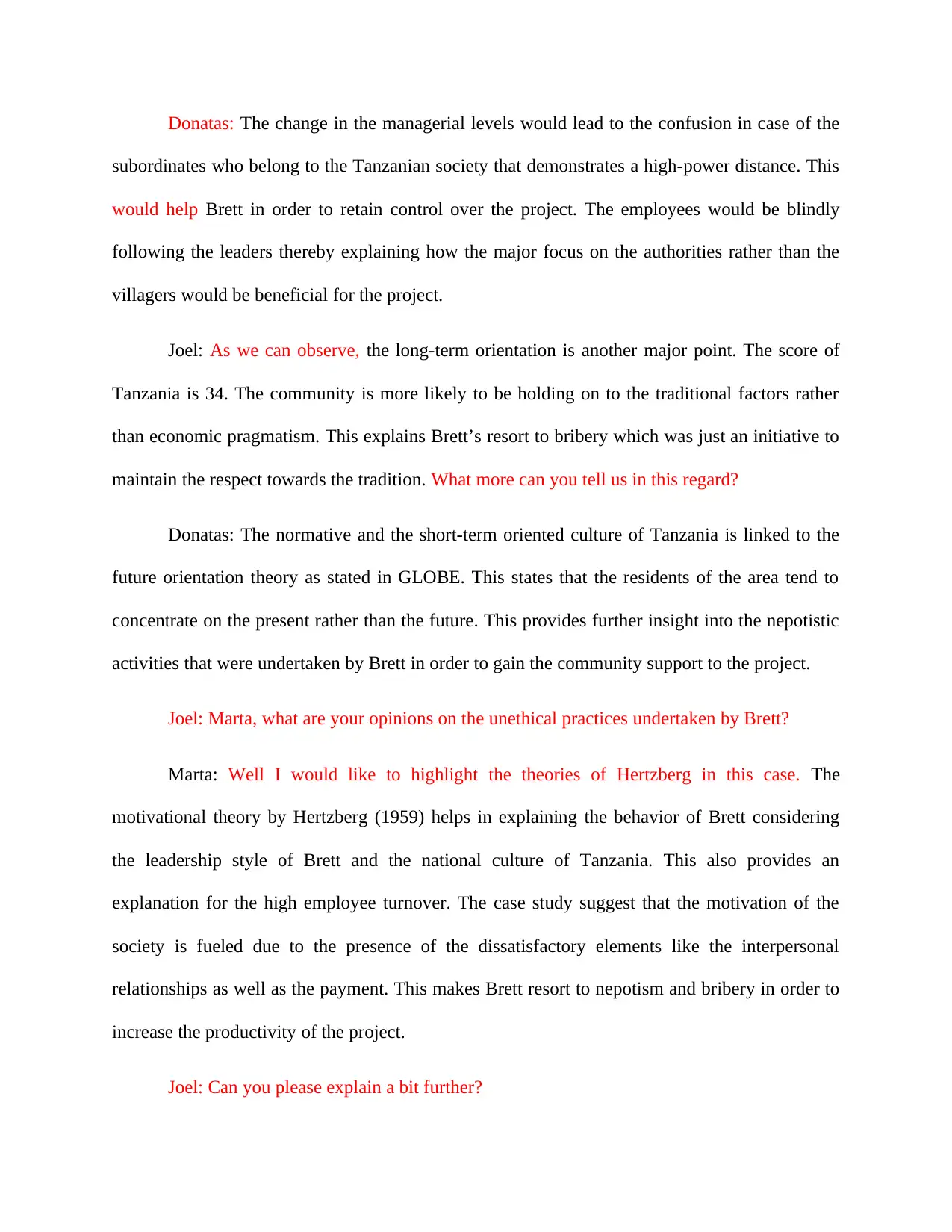
Donatas: The change in the managerial levels would lead to the confusion in case of the
subordinates who belong to the Tanzanian society that demonstrates a high-power distance. This
would help Brett in order to retain control over the project. The employees would be blindly
following the leaders thereby explaining how the major focus on the authorities rather than the
villagers would be beneficial for the project.
Joel: As we can observe, the long-term orientation is another major point. The score of
Tanzania is 34. The community is more likely to be holding on to the traditional factors rather
than economic pragmatism. This explains Brett’s resort to bribery which was just an initiative to
maintain the respect towards the tradition. What more can you tell us in this regard?
Donatas: The normative and the short-term oriented culture of Tanzania is linked to the
future orientation theory as stated in GLOBE. This states that the residents of the area tend to
concentrate on the present rather than the future. This provides further insight into the nepotistic
activities that were undertaken by Brett in order to gain the community support to the project.
Joel: Marta, what are your opinions on the unethical practices undertaken by Brett?
Marta: Well I would like to highlight the theories of Hertzberg in this case. The
motivational theory by Hertzberg (1959) helps in explaining the behavior of Brett considering
the leadership style of Brett and the national culture of Tanzania. This also provides an
explanation for the high employee turnover. The case study suggest that the motivation of the
society is fueled due to the presence of the dissatisfactory elements like the interpersonal
relationships as well as the payment. This makes Brett resort to nepotism and bribery in order to
increase the productivity of the project.
Joel: Can you please explain a bit further?
subordinates who belong to the Tanzanian society that demonstrates a high-power distance. This
would help Brett in order to retain control over the project. The employees would be blindly
following the leaders thereby explaining how the major focus on the authorities rather than the
villagers would be beneficial for the project.
Joel: As we can observe, the long-term orientation is another major point. The score of
Tanzania is 34. The community is more likely to be holding on to the traditional factors rather
than economic pragmatism. This explains Brett’s resort to bribery which was just an initiative to
maintain the respect towards the tradition. What more can you tell us in this regard?
Donatas: The normative and the short-term oriented culture of Tanzania is linked to the
future orientation theory as stated in GLOBE. This states that the residents of the area tend to
concentrate on the present rather than the future. This provides further insight into the nepotistic
activities that were undertaken by Brett in order to gain the community support to the project.
Joel: Marta, what are your opinions on the unethical practices undertaken by Brett?
Marta: Well I would like to highlight the theories of Hertzberg in this case. The
motivational theory by Hertzberg (1959) helps in explaining the behavior of Brett considering
the leadership style of Brett and the national culture of Tanzania. This also provides an
explanation for the high employee turnover. The case study suggest that the motivation of the
society is fueled due to the presence of the dissatisfactory elements like the interpersonal
relationships as well as the payment. This makes Brett resort to nepotism and bribery in order to
increase the productivity of the project.
Joel: Can you please explain a bit further?
Paraphrase This Document
Need a fresh take? Get an instant paraphrase of this document with our AI Paraphraser

Marta: The motivators like the opportunities of growth and promotion as well as the
achievement senses influence the stakeholders involved with the project. These factors also help
in the increment of the efficiency and the effectivity of the project thereby arresting the
employee turnover rates.
Joel: How would that help in motivating the employees?
Marta: This motivational technique might prove ineffective due to the short-term oriented
culture in the country that leading the people to concentrate on the present rather than the future.
Thus, the employee can be motivated by implementing the motivators on the authoritative people
which would also help in the increase of the local support.
*(A music jingle of an advertisement starts playing)*
Joel: Welcome back to the discussion. The other issue faced by the project is the increase
in its cost due to the additional fees that had to be extended towards the leaders of the tribes. The
tradition of bribery within the community is explicable through the long-term orientation within
Tanzania. The payment that Brett extends to the tribal leader is considered to be unethical from
the Western cultural viewpoint which had the power to have a negative effect on the project
scope. Well, Antonella, can we know on your views on this?
Antonella: The tradition is impacted gravely by the score of the long-term orientation.
The individual score of Tanzania is 25. This is indicative of the fact that the community upholds
a collective society which presents paramount importance to loyalty over all the other regulations
and rules of the society. The offensive activities within the collectivist societies are known to
lead to the shaming of the person committing the offense.
achievement senses influence the stakeholders involved with the project. These factors also help
in the increment of the efficiency and the effectivity of the project thereby arresting the
employee turnover rates.
Joel: How would that help in motivating the employees?
Marta: This motivational technique might prove ineffective due to the short-term oriented
culture in the country that leading the people to concentrate on the present rather than the future.
Thus, the employee can be motivated by implementing the motivators on the authoritative people
which would also help in the increase of the local support.
*(A music jingle of an advertisement starts playing)*
Joel: Welcome back to the discussion. The other issue faced by the project is the increase
in its cost due to the additional fees that had to be extended towards the leaders of the tribes. The
tradition of bribery within the community is explicable through the long-term orientation within
Tanzania. The payment that Brett extends to the tribal leader is considered to be unethical from
the Western cultural viewpoint which had the power to have a negative effect on the project
scope. Well, Antonella, can we know on your views on this?
Antonella: The tradition is impacted gravely by the score of the long-term orientation.
The individual score of Tanzania is 25. This is indicative of the fact that the community upholds
a collective society which presents paramount importance to loyalty over all the other regulations
and rules of the society. The offensive activities within the collectivist societies are known to
lead to the shaming of the person committing the offense.
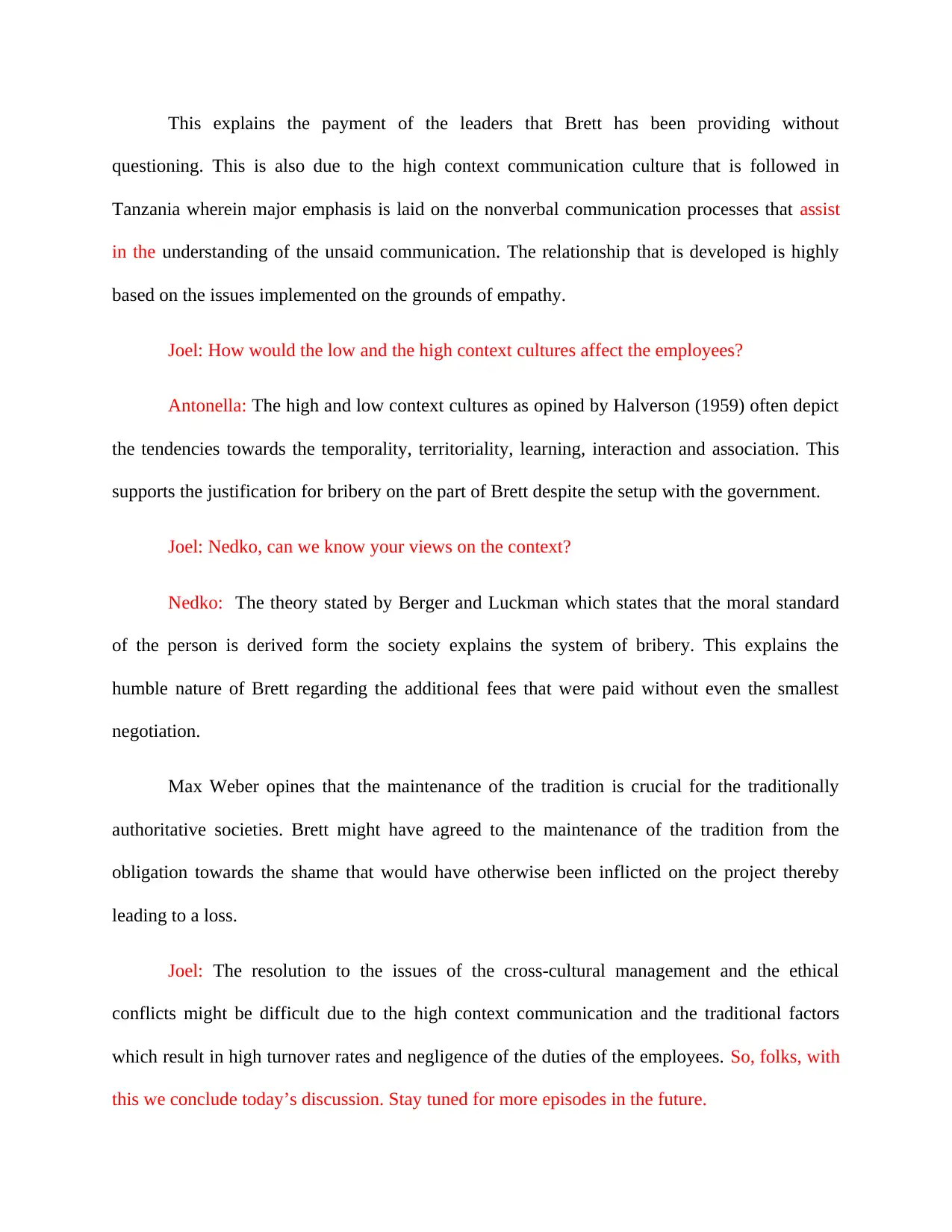
This explains the payment of the leaders that Brett has been providing without
questioning. This is also due to the high context communication culture that is followed in
Tanzania wherein major emphasis is laid on the nonverbal communication processes that assist
in the understanding of the unsaid communication. The relationship that is developed is highly
based on the issues implemented on the grounds of empathy.
Joel: How would the low and the high context cultures affect the employees?
Antonella: The high and low context cultures as opined by Halverson (1959) often depict
the tendencies towards the temporality, territoriality, learning, interaction and association. This
supports the justification for bribery on the part of Brett despite the setup with the government.
Joel: Nedko, can we know your views on the context?
Nedko: The theory stated by Berger and Luckman which states that the moral standard
of the person is derived form the society explains the system of bribery. This explains the
humble nature of Brett regarding the additional fees that were paid without even the smallest
negotiation.
Max Weber opines that the maintenance of the tradition is crucial for the traditionally
authoritative societies. Brett might have agreed to the maintenance of the tradition from the
obligation towards the shame that would have otherwise been inflicted on the project thereby
leading to a loss.
Joel: The resolution to the issues of the cross-cultural management and the ethical
conflicts might be difficult due to the high context communication and the traditional factors
which result in high turnover rates and negligence of the duties of the employees. So, folks, with
this we conclude today’s discussion. Stay tuned for more episodes in the future.
questioning. This is also due to the high context communication culture that is followed in
Tanzania wherein major emphasis is laid on the nonverbal communication processes that assist
in the understanding of the unsaid communication. The relationship that is developed is highly
based on the issues implemented on the grounds of empathy.
Joel: How would the low and the high context cultures affect the employees?
Antonella: The high and low context cultures as opined by Halverson (1959) often depict
the tendencies towards the temporality, territoriality, learning, interaction and association. This
supports the justification for bribery on the part of Brett despite the setup with the government.
Joel: Nedko, can we know your views on the context?
Nedko: The theory stated by Berger and Luckman which states that the moral standard
of the person is derived form the society explains the system of bribery. This explains the
humble nature of Brett regarding the additional fees that were paid without even the smallest
negotiation.
Max Weber opines that the maintenance of the tradition is crucial for the traditionally
authoritative societies. Brett might have agreed to the maintenance of the tradition from the
obligation towards the shame that would have otherwise been inflicted on the project thereby
leading to a loss.
Joel: The resolution to the issues of the cross-cultural management and the ethical
conflicts might be difficult due to the high context communication and the traditional factors
which result in high turnover rates and negligence of the duties of the employees. So, folks, with
this we conclude today’s discussion. Stay tuned for more episodes in the future.
⊘ This is a preview!⊘
Do you want full access?
Subscribe today to unlock all pages.

Trusted by 1+ million students worldwide

Paraphrase This Document
Need a fresh take? Get an instant paraphrase of this document with our AI Paraphraser
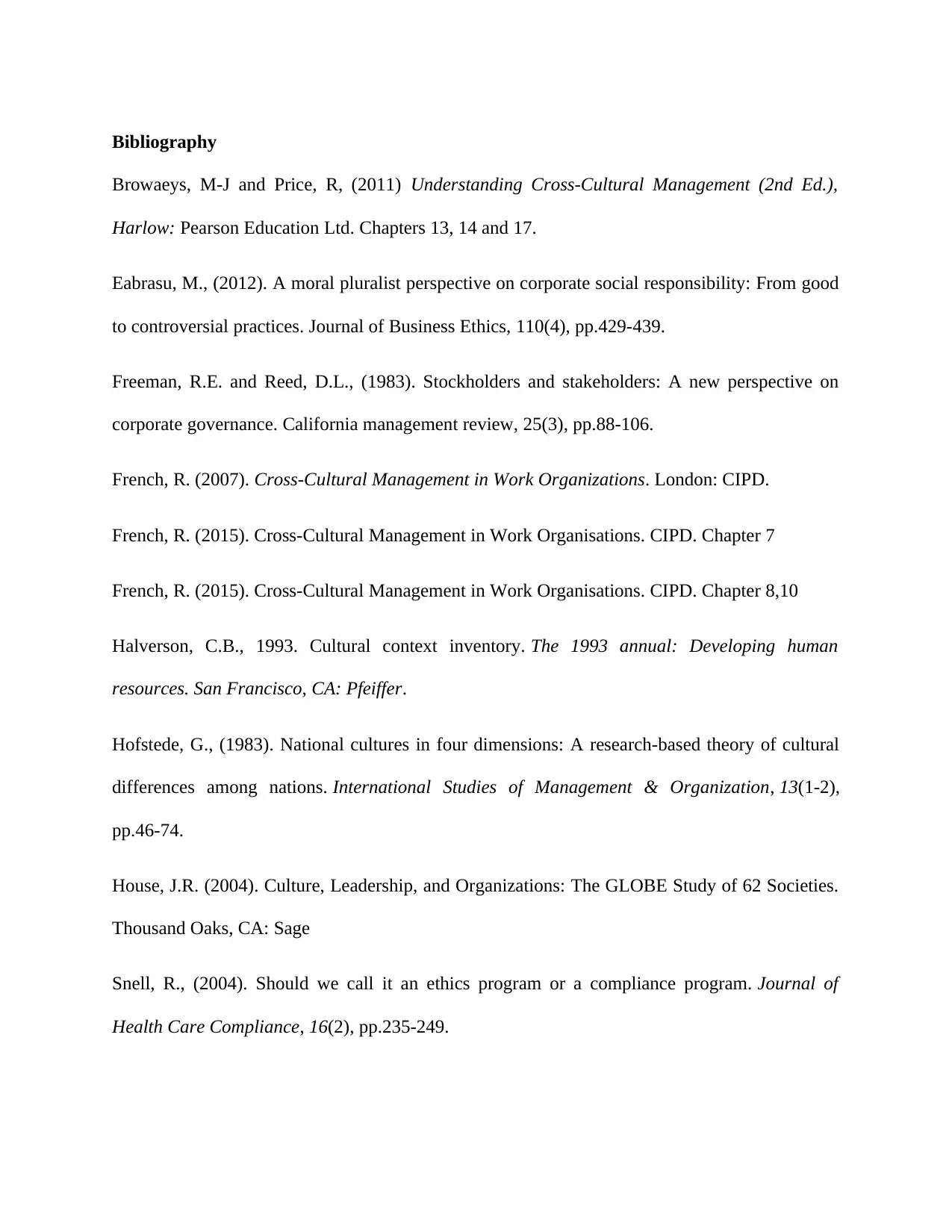
Bibliography
Browaeys, M-J and Price, R, (2011) Understanding Cross-Cultural Management (2nd Ed.),
Harlow: Pearson Education Ltd. Chapters 13, 14 and 17.
Eabrasu, M., (2012). A moral pluralist perspective on corporate social responsibility: From good
to controversial practices. Journal of Business Ethics, 110(4), pp.429-439.
Freeman, R.E. and Reed, D.L., (1983). Stockholders and stakeholders: A new perspective on
corporate governance. California management review, 25(3), pp.88-106.
French, R. (2007). Cross-Cultural Management in Work Organizations. London: CIPD.
French, R. (2015). Cross-Cultural Management in Work Organisations. CIPD. Chapter 7
French, R. (2015). Cross-Cultural Management in Work Organisations. CIPD. Chapter 8,10
Halverson, C.B., 1993. Cultural context inventory. The 1993 annual: Developing human
resources. San Francisco, CA: Pfeiffer.
Hofstede, G., (1983). National cultures in four dimensions: A research-based theory of cultural
differences among nations. International Studies of Management & Organization, 13(1-2),
pp.46-74.
House, J.R. (2004). Culture, Leadership, and Organizations: The GLOBE Study of 62 Societies.
Thousand Oaks, CA: Sage
Snell, R., (2004). Should we call it an ethics program or a compliance program. Journal of
Health Care Compliance, 16(2), pp.235-249.
Browaeys, M-J and Price, R, (2011) Understanding Cross-Cultural Management (2nd Ed.),
Harlow: Pearson Education Ltd. Chapters 13, 14 and 17.
Eabrasu, M., (2012). A moral pluralist perspective on corporate social responsibility: From good
to controversial practices. Journal of Business Ethics, 110(4), pp.429-439.
Freeman, R.E. and Reed, D.L., (1983). Stockholders and stakeholders: A new perspective on
corporate governance. California management review, 25(3), pp.88-106.
French, R. (2007). Cross-Cultural Management in Work Organizations. London: CIPD.
French, R. (2015). Cross-Cultural Management in Work Organisations. CIPD. Chapter 7
French, R. (2015). Cross-Cultural Management in Work Organisations. CIPD. Chapter 8,10
Halverson, C.B., 1993. Cultural context inventory. The 1993 annual: Developing human
resources. San Francisco, CA: Pfeiffer.
Hofstede, G., (1983). National cultures in four dimensions: A research-based theory of cultural
differences among nations. International Studies of Management & Organization, 13(1-2),
pp.46-74.
House, J.R. (2004). Culture, Leadership, and Organizations: The GLOBE Study of 62 Societies.
Thousand Oaks, CA: Sage
Snell, R., (2004). Should we call it an ethics program or a compliance program. Journal of
Health Care Compliance, 16(2), pp.235-249.
1 out of 8
Your All-in-One AI-Powered Toolkit for Academic Success.
+13062052269
info@desklib.com
Available 24*7 on WhatsApp / Email
![[object Object]](/_next/static/media/star-bottom.7253800d.svg)
Unlock your academic potential
Copyright © 2020–2025 A2Z Services. All Rights Reserved. Developed and managed by ZUCOL.


